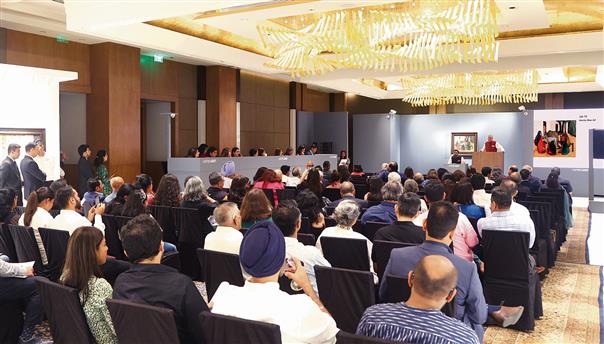
Saffronart’s Evening Sale underway in New Delhi last month.
Sarika Sharma
INDIAN art has found itself on a high in the last few weeks. On August 31, SH Raza’s ‘Gestation’ went for Rs 51.75 crore at Pundole’s Mumbai auction, setting a new record for an Indian artwork. Less than two weeks later, Amrita Sher-Gil’s ‘The Story Teller’ (1937) topped that by fetching a stupendous Rs 61.8 crore at Saffronart’s Delhi sale, becoming the highest value work of Indian art sold at an auction worldwide. In between, in September itself, AstaGuru’s Modern Treasures had broken world records for six Indian artists, some of whom had appeared in an auction for the first time. What played out over the last one month finds its genesis in the liberalisation of Indian economy in the 1990s.

Auctioneer Mallika Sagar at Pundole’s auction. Behind her is SH Raza’s 1989 painting ‘Gestation’.
Mallika Sagar, auctioneer for Pundole’s, says, “Since the early auctions of modern Indian art in the mid-1990s, prices have seen a consistent upward trajectory, barring a few cyclical troughs intrinsic to any art market. The auction market has emerged stronger each time, and has continued to show steady growth in terms of prices achieved, artists featured and the number of collectors looking to purchase artworks.”
It was in 2005 that the art market started to grow exponentially. “Many speculators saw an opportunity to make a respectable return on investment,” note Prof Filip Vermeylen and Shambhavi Bhat in their recent essay that appeared in ‘The Art Market and the Global South’. But this high was short-lived. The global recession hit the art market in India hard and many galleries closed. It was to bounce back only several years later.

The work sold for Rs 61.8 crore. photos courtesy: Saffronart & Pundole’s
In the meantime, the country got its first art fair, India Art Fair, in 2008 and the Kochi Biennale kicked off in 2012. Vermeylen and Bhat see these not only as unmissable events for the stakeholders of the Indian scene, but important outlets for local artists and galleries. They say the second surge began in 2014-15 and this leap was “driven” by art auctions. Auctions of Indian art had hitherto been sporadic, and mostly outside India.
While auction house Saffronart has been around since 2000, Pundole’s Art Gallery jumped into the auction arena in 2011. In 2018, US-based Sotheby’s held its first-ever auction in Mumbai, to great success. It included works of masters such as MF Husain, SH Raza, Amrita Sher-Gil and Tyeb Mehta. It achieved total sales of Rs 55.4 crore. ‘The Little Girl in Blue’, the Amrita Sher-Gil work that was auctioned, was unseen for 80 years when it came up at this auction. The Sher-Gil painting that featured at the recent Saffronart Evening Sale was significant for being one of the few works she painted en plein air (outdoor) and was a favourite of Sher-Gil herself.
Art historian R Siva Kumar says paintings by Sher-Gil are mostly in museums and there are only a few in private collections. Rarely does one come up for sale. “She also holds an assured place in modern Indian art history. Therefore, these are bound to fetch high prices, especially if the works are well-known and have good provenance.” Amrita-Sher-Gil’s artworks are designated as a national treasure by the Government of India and can’t be exported. Rumour has it that a leading gallerist-collector from Delhi has bought ‘The Story Teller’, which was with craft activist Laila Tyabji’s family for a long time, her father having bought it from Sher-Gil’s first exhibition at Faletti’s in Lahore.
What is true of Sher-Gil is true of the hotselling Moderns, too. Shireen Gandhy, director of one of India’s oldest galleries, the Mumbai-based Chemould Prescott Road, says the Moderns have been surging for many years now. However, she points out that the past years have seen an exponential rise, with prices hitting new heights. “The obvious reason is that the number of great works by these artists is diminishing. Today, the rarity of a good Mehta, Gaitonde or Raza is more obvious.” An artwork, she says, will thus fetch a great price because of its quality, rarity and the fact that these artists painted when there was no market.
Dinesh Vazirani, Saffronart’s CEO and co-founder, says that many artists who command high prices were associated with the Bombay Progressive Artists’ Group. “This group was formed in a conscious attempt to steer away from the styles popularised by the Bengal School of Art. While they were united in their rejection of this, the group did not have a coherent style. Their shared artistic approach was based on melding western influences with eastern artistic styles to create art suited to modern India. Over 60 per cent of all works sold in India in the previous financial year were works by Modern artists.”
Certain artists are always seen to be more collectible for a variety of reasons. As Mallika says: “It could be the critical role they played in the development of the art movement of the region, as seen with the contribution of the Progressives and other post-Independence Modernists. It could be their dynamic personality that led to re-defining the national identity of Indian art, as seen in the works of Amrita Sher-Gil. For others, it’s their innate curiosity and talent that led to the creation of a new visual vocabulary, as seen in the works of Raja Ravi Varma, who not only introduced oil as a new medium, but also allowed for the dissemination of art to a wider audience through his oleographs.”
Interestingly, the second surge saw an increasing interest in artists such as Anish Kapoor, Subodh Gupta and Jitish Kallat. Hurun India Art List, released in August 2023, ranked India’s 50 most successful artists alive today by the sales of their works sold at public auctions in the year ending on July 31, 2023. The list was topped by Anish Kapoor for the fifth time in a row. “His remarkable achievement is attributed to the impressive sales of his artworks at a public auction, totalling an impressive Rs 91 crore,” Hurun India said. He was followed by banker-turned modernist painter Arpita Singh, figurative artist Jogen Chowdhury, modern and contemporary artist Gulam Mohammed Sheikh and Krishen Khanna, the last of the Progressives alive. Number 7 on the list was 26-year-old Raghav Babbar, born in Rohtak and based in London.
The majority of buyers across all values in Pundole’s auctions is primarily Indian. “With the emergence of such a strong local auction market, young professional Indians are seizing the chance to begin collecting works by Indian artists,” says Mallika. At Saffronart, most buyers would fall between the ages of 30 and 50. “We retain long-standing relationships with seasoned collectors who are keen on further building their collections. The new, younger buyers bend more towards works by contemporary artists,” says Vazirani.
Amrita Sher-Gil died at 28. Understandably, she wasn’t as popular as she is today. Her biographer Yashodhara Dalmia writes that that in her lifetime, she had to run from pillar to post for a few hundred rupees. How does one then see this sudden legend status for her works as that of the other artists who are darlings of the auction circuit?
Mahendra Damle, former professor at Sir JJ School of Art and presently a faculty member with Rachna Sansad, an academy of fine arts, says: “One needs to understand that once an artwork comes in the market, it is a commodity. We generally ask how come some artists get prices so high in auctions, but we do not ask why art galleries are closing their galleries and focusing only on auctions. Actually, if the auctioneers realise they can generate interest about an artwork or an artist, they set the auction. Many times the same artists, or their other art works, do not get noticed or generate response in auctions as well.”
Nonetheless, the market is cheerful at the moment. Vazirani says a thriving art market is the result of a robust art scene. “Our art world has matured, thanks to the infrastructure coming into place with institutional support. Many buyers have had the opportunity to establish or renew a deep connection with art through the growing number of galleries, art fairs, exhibitions and auction houses.”
Online shift
During the pandemic, when most businesses were facing a hard time, the art market was flourishing. Pundole’s Mallika Sagar says that both within India and internationally, the art market saw spirited growth during Covid, reiterating the importance of technology and trust. “Collectors grew comfortable buying expensive artworks without being able to physically see them, largely due to the options we have to share images/videos, but also because there is a huge element of trust,” she says. Saffronart’s CEO Dinesh Vazirani says online auctions are very inviting to potential collectors who would not otherwise have had access to physical auctions. “We can expect to see an influx of new buyers as more auction houses adopt these practices.” Earlier, Saffronart became the first to introduce bidding by mobile phone, notes Prof Filip Vermeylen.
Join Whatsapp Channel of The Tribune for latest updates.



























